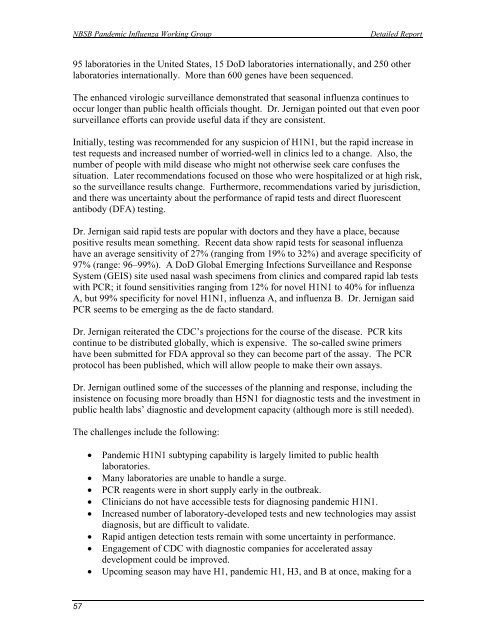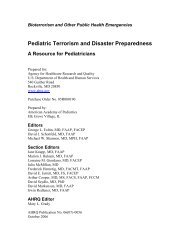H1N1 COUNTERMEASURES STRATEGY AND ... - PHE Home
H1N1 COUNTERMEASURES STRATEGY AND ... - PHE Home
H1N1 COUNTERMEASURES STRATEGY AND ... - PHE Home
Create successful ePaper yourself
Turn your PDF publications into a flip-book with our unique Google optimized e-Paper software.
NBSB Pandemic Influenza Working Group<br />
Detailed Report<br />
95 laboratories in the United States, 15 DoD laboratories internationally, and 250 other<br />
laboratories internationally. More than 600 genes have been sequenced.<br />
The enhanced virologic surveillance demonstrated that seasonal influenza continues to<br />
occur longer than public health officials thought. Dr. Jernigan pointed out that even poor<br />
surveillance efforts can provide useful data if they are consistent.<br />
Initially, testing was recommended for any suspicion of <strong>H1N1</strong>, but the rapid increase in<br />
test requests and increased number of worried-well in clinics led to a change. Also, the<br />
number of people with mild disease who might not otherwise seek care confuses the<br />
situation. Later recommendations focused on those who were hospitalized or at high risk,<br />
so the surveillance results change. Furthermore, recommendations varied by jurisdiction,<br />
and there was uncertainty about the performance of rapid tests and direct fluorescent<br />
antibody (DFA) testing.<br />
Dr. Jernigan said rapid tests are popular with doctors and they have a place, because<br />
positive results mean something. Recent data show rapid tests for seasonal influenza<br />
have an average sensitivity of 27% (ranging from 19% to 32%) and average specificity of<br />
97% (range: 96–99%). A DoD Global Emerging Infections Surveillance and Response<br />
System (GEIS) site used nasal wash specimens from clinics and compared rapid lab tests<br />
with PCR; it found sensitivities ranging from 12% for novel <strong>H1N1</strong> to 40% for influenza<br />
A, but 99% specificity for novel <strong>H1N1</strong>, influenza A, and influenza B. Dr. Jernigan said<br />
PCR seems to be emerging as the de facto standard.<br />
Dr. Jernigan reiterated the CDC’s projections for the course of the disease. PCR kits<br />
continue to be distributed globally, which is expensive. The so-called swine primers<br />
have been submitted for FDA approval so they can become part of the assay. The PCR<br />
protocol has been published, which will allow people to make their own assays.<br />
Dr. Jernigan outlined some of the successes of the planning and response, including the<br />
insistence on focusing more broadly than H5N1 for diagnostic tests and the investment in<br />
public health labs’ diagnostic and development capacity (although more is still needed).<br />
The challenges include the following:<br />
<br />
<br />
<br />
<br />
<br />
<br />
<br />
<br />
Pandemic <strong>H1N1</strong> subtyping capability is largely limited to public health<br />
laboratories.<br />
Many laboratories are unable to handle a surge.<br />
PCR reagents were in short supply early in the outbreak.<br />
Clinicians do not have accessible tests for diagnosing pandemic <strong>H1N1</strong>.<br />
Increased number of laboratory-developed tests and new technologies may assist<br />
diagnosis, but are difficult to validate.<br />
Rapid antigen detection tests remain with some uncertainty in performance.<br />
Engagement of CDC with diagnostic companies for accelerated assay<br />
development could be improved.<br />
Upcoming season may have H1, pandemic H1, H3, and B at once, making for a<br />
57
















